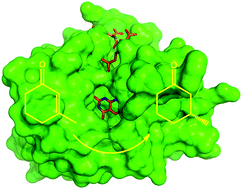当前位置:
X-MOL 学术
›
Chem. Commun.
›
论文详情
Our official English website, www.x-mol.net, welcomes your
feedback! (Note: you will need to create a separate account there.)
Enantio- and regioselective ene-reductions using F420H2-dependent enzymes†
Chemical Communications ( IF 4.3 ) Pub Date : 2018-09-12 00:00:00 , DOI: 10.1039/c8cc04449j Sam Mathew 1, 2, 3 , Milos Trajkovic 1, 2, 3 , Hemant Kumar 1, 2, 3 , Quoc-Thai Nguyen 4, 5, 6 , Marco W. Fraaije 1, 2, 3
Chemical Communications ( IF 4.3 ) Pub Date : 2018-09-12 00:00:00 , DOI: 10.1039/c8cc04449j Sam Mathew 1, 2, 3 , Milos Trajkovic 1, 2, 3 , Hemant Kumar 1, 2, 3 , Quoc-Thai Nguyen 4, 5, 6 , Marco W. Fraaije 1, 2, 3
Affiliation

|
In the past decade it has become clear that many microbes harbor enzymes that employ an unusual flavin cofactor, the F420 deazaflavin cofactor. Herein we show that F420-dependent reductases (FDRs) can successfully perform enantio-, regio- and chemoselective ene-reductions. For the first time, we have demonstrated that F420H2-driven reductases can be used as biocatalysts for the reduction of α,β-unsaturated ketones and aldehydes with good conversions (>99%) and excellent regioselectivities and enantiomeric excesses (>99% ee). Noteworthily, FDRs typically display an opposite enantioselectivity when compared to the well established FMN-dependent Old Yellow Enzymes (OYEs).
中文翻译:

使用依赖于F 420 H 2的酶进行对 映和区域选择性烯还原†
在过去的十年中,很明显,许多微生物都带有使用不常见的黄素辅助因子F 420去氮黄素辅助因子的酶。本文中,我们显示了依赖F 420的还原酶(FDR)可以成功地进行对映体,区域和化学选择性烯的还原。首次,我们证明了F 420 H 2驱动的还原酶可用作生物催化剂,以良好的转化率(> 99%)以及优异的区域选择性和对映体过量(> 99)还原α,β-不饱和酮和醛。 %ee)。值得注意的是,与公认的FMN依赖的旧黄色酶(OYE)相比,FDR通常显示相反的对映选择性。
更新日期:2018-09-12
中文翻译:

使用依赖于F 420 H 2的酶进行对 映和区域选择性烯还原†
在过去的十年中,很明显,许多微生物都带有使用不常见的黄素辅助因子F 420去氮黄素辅助因子的酶。本文中,我们显示了依赖F 420的还原酶(FDR)可以成功地进行对映体,区域和化学选择性烯的还原。首次,我们证明了F 420 H 2驱动的还原酶可用作生物催化剂,以良好的转化率(> 99%)以及优异的区域选择性和对映体过量(> 99)还原α,β-不饱和酮和醛。 %ee)。值得注意的是,与公认的FMN依赖的旧黄色酶(OYE)相比,FDR通常显示相反的对映选择性。











































 京公网安备 11010802027423号
京公网安备 11010802027423号